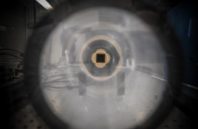Physicists are exploring laser-based technology to shine a light on the subtlest features of mosquito activity and better track populations that may carry a viral threat. With more than 2500 different species of mosquitoes known on Earth today, many challenges remain for entomologists and disease control experts aiming to monitor evolving mosquito populations and infectious mosquito-borne disease that affects nearly 700 million people worldwide and results in more than 1 million human deaths each year.
An investigation led by Benjamin Thomas, assistant professor of physics at the New Jersey Institute of Technology (NJIT; Newark, NJ), has adopted the use of light detection and ranging (lidar), an infrared optical remote-sensing technology capable of capturing the rate that mosquitoes beat their wings in flight, known as wing beat frequency (WBF). By understanding variations of WBF in mosquitoes, Thomas’ lab is learning two key characteristics that can help distinguish which mosquitoes may be vectors for infectious disease, from those that are not: species and gender.

 (585) 768-2513
(585) 768-2513

